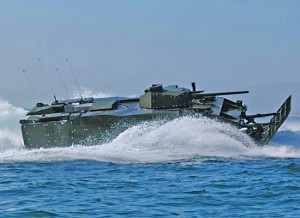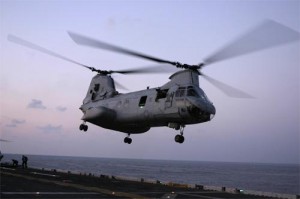Marine Corps Prepares for Budget Cuts
BY Herschel SmithWhen it comes to defense spending generally, I have pointed out before that the percentage of defense budget versus GDP has shrunk over time for the U.S. The notion of defense spending that is out of control is a perception created by a liberal administration bent of printing and spending trillions of dollars on entitlements and redistribution of wealth rather than defense . Little more needs to be said about that because of the obvious disparity in interests of this administration.
However, that doesn’t mean that any particular branch of the service has spent money wisely. Regarding the concept of expeditionary warfare floated by Commandant Conway, I have pointed out how inherently contradictory it is. Conway believes that the Corps is getting too heavy, yet he invests an incredible amount of money in the Expeditionary Fighting Vehicle. He believes that the Corps needs to be capable of many kinds of warfare with its equipment, but invests in implements of warfare intended to perform only one task: forcible entry under conditions of heavy fire from numerous opposing forces.
The EFV is designed for a near peer state (or close to it), and its presupposition is active enemy fire while ferrying troops ashore while providing covering fire. It is a reversion to 65-year old amphibious warfare doctrine with updated equipment. But if the state upon which we intend to conduct forcible entry is capable of rocket fire against navy vessels (positioned 25 miles offshore over the horizon in order to increase the likelihood of survival), the EFVs will become deadly transport vehicles for Marines. If the nation-state is in fact not capable of such opposing fire, then the EFV is not needed.
The U.S. will never again conduct a major, large scale, amphibious-based forcible entry that relies upon sea-based approach for the initial assault. I have recommended an alternative, namely amphibious-based forcible entry via air based on a new Marine Corps helicopter fleet. After securing the beach head, Naval assets can ferry heavier equipment to shore if necessary. Air-based entry, including transport (helicopter and V-22 Osprey) and attack helicopter is the way to go, and would address even the example of the synthesized nation-state / terrorist entity, namely Hezbollah in Lebanon who is presumed to have such rockets due to Iranian assistance.
But the Marines are preparing for major cuts, and if it comes down to it, it appears that the wasteful billions spent on large scale amphibious assaults will be addressed by cutting the very things needed in the twenty first century. Troops are needed, and a replacement for the M16 is needed, and we need an end to the so-called Terminal Lance problem. Many of the well trained infantry who took Iraq in 2004 – 2007 have left the Corps, and the most of the Marines who are in Afghanistan have not seen combat.
But in the end, ambitious programs get the dollars and the grunts pay for the wishful 65-year old thinking of outdated officers who cannot abandon their doctrinaire ideas.
For a sneak peek into the Marine Corps’ future needs, one can look at the recent past. As 4,000 marines in January were amassing for a large-scale attack on Marja, Afghanistan, another 4,000 marines were sailing to Haiti to assist in relief operations in the earthquake-devastated nation. Thousands more were carrying out other missions around the globe.
Marine officials say that the force in the coming decades will be just as busy, but it will have to do the job with fewer resources.
“We have an expression in the Corps: ‘We sometimes have to do more with less,’ and I honestly think that’s what we face in the not-so-distant future,” said Gen. James T. Conway, commandant of the Marine Corps.
Flexibility in equipment, organization and training will be critical, Lt. Gen. George Flynn, commanding general of the Marine Corps Combat Development Command, told industry representatives at a National Defense Industrial Association conference. Marines can expect to prepare for irregular warfare, conventional warfare and terrorism. “We will never know which one we’re facing until the game is called,” he said.
The Defense Department has adjusted doctrine and strategies to reflect this new “hybrid” reality. Operations in Iraq and Afghanistan have helped to expedite changes in force structure and equipment, but they also have drained the treasury.
“As monies get tight, we’re going to have to look at equipment sets that are entirely interoperable, lighter, cheaper ideally, but that will nevertheless get the job done to defend this great country,” said Conway in remarks at the NDIA annual dinner in McLean, Va.
Though its budget request for fiscal 2011 totals $26.6 billion with an additional $7 billion in supplemental war funding, the Marine Corps is fast approaching a crossroads that will force its leaders to make some difficult decisions. Anticipating smaller budgets in the coming decade, officials will have to determine how to modernize war-torn gear while pursuing advanced technologies.
“We will have to balance investment between current and future challenges,” Flynn said.
Marine leaders said they remain focused on supporting operations in Afghanistan, and they are planning to stay the course through 2015. But doing so may be compromising the Corps’ preparedness for future contingencies.
“It may well be that we don’t have everything we want but only what we have to have. And we will have to cut away some capability and do without some things that we think are absolutely essential to the various missions that are out there,” Conway said.
To reduce that risk, the Corps is seeking gear that will have applicability across the full spectrum of warfare. All new equipment will have to have utility in high- and low-intensity conflict, counterterrorism and disaster relief operations.
“If you have something that operates across all four of those mission tasks, we’re really going to be interested,” Flynn said.
Officials insist that vehicles need to be lighter to allow the force to get to the fight and also enhance the Marine Corps’ amphibious capability to maneuver from the sea to the shore. In addition, weapon systems must be affordable and help the service decrease its dependence on fossil fuels.
That wish list is a tall order, officials acknowledged, especially given the exponential growth in the cost of military hardware.
“They have to come in at the amount that we have budgeted, on the schedule we have allotted, with the performance that we have been promised, because there isn’t going to be a second bite of the apple,” warned Brig. Gen. Michael Brogan, commander of Marine Corps Systems Command.
Marine officials are still uncertain whether recent acquisition reforms will help reduce costs.
President Obama last year signed the Weapon Systems Acquisition Reform Act of 2009 into law. The legislation is meant to fix the Pentagon’s troubled procurement system by giving officials increased oversight of major defense programs.
“It demands more reports going to the Hill,” said Brogan. “A lot of burden flows down to program managers.”
The new law puts more pressure on procurement officials to keep programs on budget, agreed Bill Taylor, program executive officer for land systems, which is the Marine Corps’ largest acquisition portfolio.
“Historically, it’s a fact that our programs come in over budget and years late. Report after report has indicated that the key to successful acquisition programs is getting things right at program inception with sound systems engineering, cost estimation and legitimate developmental testing,” said Taylor.
Burden. That’s the way reportability to Congress is being described. Burden. As for the Obama administration, they need to stop printing money and giving it away on entitlement programs. As for the DoD, they need to create a viable procurement program. As for the Marine Corps, they need to develop doctrine that represents and reflects twenty first century concerns – and be able to explain it to the taxpayers. That is not a burden.






